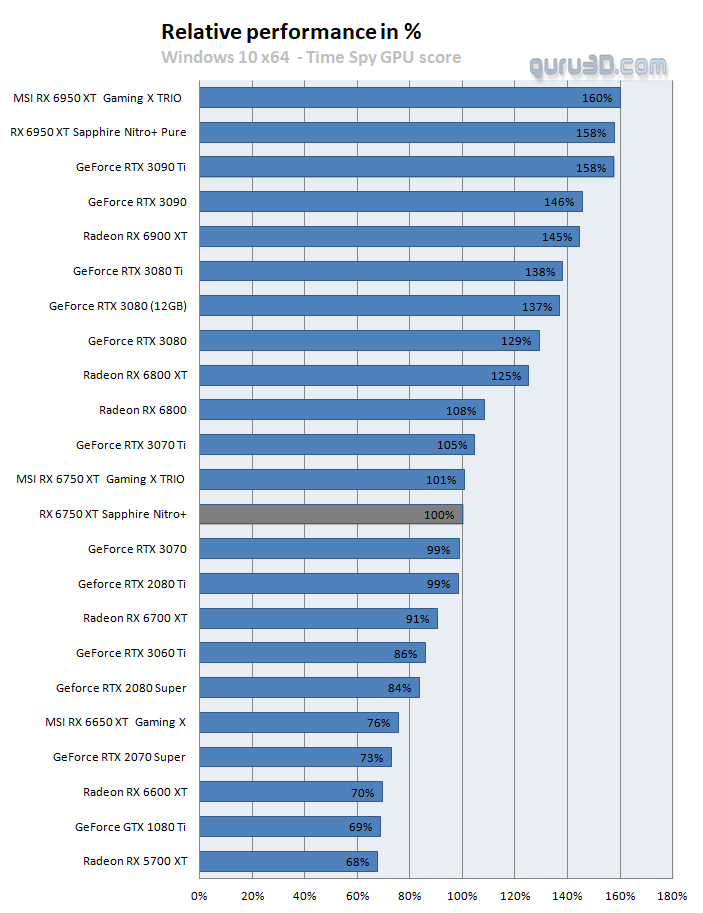Final words and conclusion
Final words
The factory boost clock on the SAPPHIRE NITRO+ Radeon RX 6750 XT GAMING OC is 2623MHz. Out of the box, this performs better than a reference video card, however since AMD is not distributing these for review, it'll be a bit of a wild guess. To support the powerful cooling and three fan architecture, the mainstream video card is physically larger in every dimension. The heatsink extends beyond the PCB, allowing the heatsink and heatpipes to be cooled by pass-through air. The backplate is adequately vented and provides cooling via thermal pads. It is possible that the standard RX 6750 XT performs similarly to the RTX 3070 Ti and sometimes 3080, but solely in terms of shading performance. Raytracing performance is significantly slower than that of the rivals. Also, this is mainly in the lower resolutions thanks to caching techniques applied. While the Infinity cache works well in most cases, it was designed as a workaround for a flaw in the memory type chosen (GDDR6 versus GDDR6X), and the current AMD GPUs are memory bandwidth constrained, even when using GDDR6 at 18 Gbps, but especially when using a 192-bit wide memory bus. We question AMD's attempt to justify a price of 549 USD though.
Performance spread reference
We've been fairly busy over the last week or so, with eight Radeon RX 6x50 XT reviews lined up, technically more as we're still waiting on other brand samples as well. Thus, the variances are not enormous from top to bottom; have a look:
The outcome above is arbitrary in that it varies by a single percent here and there, less so in fillrate-constrained cases and more so in GPU-constrained ones. However, when compared to the fastest AIB cards, you're looking at 3 to 4% differentials (depending on game and resolution). Mind you, AMD did not supply reference samples, thus you're looking at AIB results.
Cooling & acoustic
Sapphire features a well-designed cooling system. Expect a game load temperature of just over 65 degrees Celsius, depending on the internal airflow of your chassis. While the device remains rather silent acoustically, it reaches a 34 DBa level with this NITRO+ model, owing mostly to the measured ~275 power design. It is, nevertheless, sufficiently quiet. Our FLIR imagery demonstrates that the card is slightly losing heat. In general, we are rather content with what we witness.
Energy
Heat output and energy consumption are closely related to each other, as (graphics) processors and heat can be perceived as a 1:1 state; 250 Watts in energy consumption approaches close to 250 Watts in heat as output. This is the basis of TDP. AMD is listing the card at 250W, which is okay at best for a graphics card in the year 2022. We measure numbers slightly above the XT's advertised values; we measure the entire power consumption of the card to close in at ~275 Watt, that's total board power not TGP (fans and RGB can easily utilize 10~15 Watts). The card can peak to 300W (spikes).
Coil whine
Coil squeal hardly was present on the 6750 XT, just as it is on any other card these days, albeit to a smaller extent than usual. Is it a bothersome annoyance? It is, without a doubt, at a volume that is difficult no concern. This type of noise would be muffled in a closed chassis and fade into the background. On the other hand, with an open chassis, you may hear coil whine/squeal. In some way or another, all graphics cards do this, especially when running at higher frame rates; this can be perceived.
Pricing
AMD has done a great job with NAVI22. However, the price of an entry-level to mainstream graphics card has risen to $549. The model listed and tested today under SKU code 11318-01-20G, will cost $619. Too pricy? Yes, probably. The cards sit close to RTX 3070 series performance though, but only in shading performance. Raw Raytracing's performance lags behind the competitors.
Tweaking
The RX 6750 XT enjoys having more memory bandwidth available to it. You can add it manually and get up to 18.5; however, results will vary depending on the board, brand, and even card due to cooling (GDDR6/GPU/VRM) and other factors. With a little GPU tweaking, we could get this AMD Navi GPU to run at a very respectable 2950 MHz. And that's without any anomalies or crashes of any kind. The dynamic clock frequency is now hovering in the ~2900 MHz range, depending on the load, game/app, and board assigned power. Even so, that's quite a feat. As is always the case, all of your tweaking and increased energy consumption will only provide you with a maximum of ~5% improvement in performance (depending on your results and model graphics card). It must successfully complete four-game runs (in four different games) in 2560x1440 resolution in order to be considered stable enough to be listed here.
Conclusion
The Radeon RX 6750 XT's foundation architecture is sound, Sapphire enhanced it with a more sophisticated PCB design, component choices, and a beefier triple-fan cooler. SAPPHIRE has a one-of-a-kind cooling module designed to keep the memory, VRMs, MOSFETs, and Chokes cool. The GPU stays cool and silent while gaming thanks to IC-powered fan technologies that keep the fans running precisely. This video card can also overclock.It should come as no surprise that Ray Tracing is not the Radeon RX 6750 XT's strong suit. In this field, NVIDIA RTX GPUs typically outperform it. As previously said, this is an excellent Full HD and Quad HD card with Ultra HD capabilities. Raytracing performance on this generation RDNA2 card is adequate and allows for some experimentation with it.SAPPHIRE's cooling technology does an excellent job of keeping the GPU cool and quiet. It has a larger footprint than the reference video card, but it has better cooling and runs more quietly. Furthermore, it can overclock while remaining incredibly cool and silent. Overclocking is the only way to get the Radeon RX 6750 XT to burst out of its shell and compete in rasterized performance with the GeForce RTX 3070 Series.AMD is lacking in DLSS capabilities but does give your RSR. All of this might be forgiven if the product were reasonably priced, which it is not. We believe the card as tested will retail for around 550~600 USD, and although we can suggest the card for gaming at 2560x1440, we cannot justify the confusing price tag. It's a lovely build though, proper quality with all the right boxes being ticked. The Nitro+ cards are always well-thought-out, and we can see Sapphire has done a superb job of considering most users' needs and providing a well-rounded solution as a result.
Sign up to receive a notification when we publish a new article.
Or go back to Guru3D's front page.
- Hilbert, LOAD"*",8,1.


